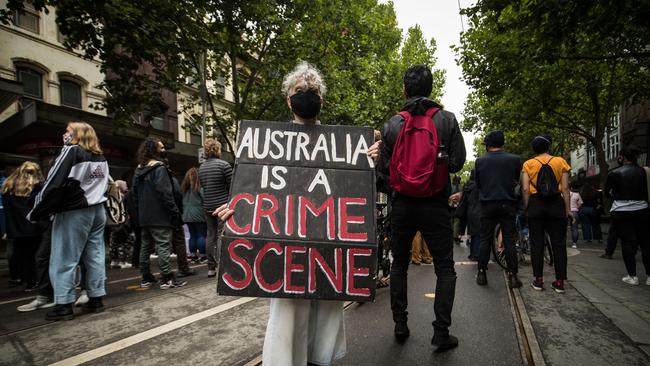Rioters are blurring lines between present and past

After delving into the subject, I realised that the idea of a border increasingly was framed in a negative light by many educators, media commentators and cultural influencers. Nor was their celebration of open borders confined to the boundaries that separated nations. I came to the conclusion that animosity towards physical borders between nations was often echoed in controversies about the meaning of symbolic boundaries between adults and children, men and women, humans and animals, the private and public sphere.
In recent years those who affirm a clear-cut distinction between a man and a woman or a child and an adult risk being denounced as reactionary, transphobic or prejudiced.
It seemed to me that except in unusual circumstances — such as the COVID pandemic — Western society had become estranged from hitherto conventional borders and boundaries. In effect the symbolic signposts that have given meaning to people’s lives across the centuries are now castigated as outdated relics that reflect the prejudices of the bad old days
It was while my book Why Borders Matter was at the printer that I realised that I should have written a chapter on the unravelling of one of the most important boundaries that governs our lives: the one that separates the present from the past.
In recent months, protesters have targeted historic symbols of Western culture as if these statues constitute a clear and present danger to their wellbeing. They are denounced as if they are living figures responsible for the many ills inflicted on the world. Through targeting a nation’s history, angry rioters appear to have lost sight of the distinction between the present and the past. Worse still, the campaigns for the toppling of statues in the US, Australia, Britain and other regions of the Western world are not simply focused on ridding the world of physical objects but also detaching society from its past.
Contaminating the past
In the Western world the past has become the target of an ideological crusade. Many of its historic monuments and symbols are vandalised, defaced or destroyed. In the Anglo-American world the national flag frequently is treated with derision and denounced by leading members of its cultural institutions as symbols of racism, oppression and discrimination. Commentators regularly condemn their nation’s past and portray it as a source of eternal shame.
Casual references to Australia’s “dark past” or “genocidal history” abound to the point where young children, who know little about the subject, could easily feel ashamed about the nightmarish society into which they were born. Their shame would be reinforced if they were to read a commentator explaining to the readers of The Sydney Morning Herald that the “statues must fall” because of Australia’s “brutal colonial history”.
Though its target is Australia’s past, the main aim of this crusade is to erode the legitimacy of the nation in the here and now. The protesters against the statues of historic figures and their supporters in the media and other cultural institutions are in effect calling into question the moral integrity of present-day Australia. This aspiration was clearly voiced by demonstrators on January 26, Australia Day. Instead of celebrating this occasion, many protesters denounced it and characterised it as Invasion Day. The demonstrators did not simply criticise the misdeeds and crimes committed during the course of the nation’s distant history. As far as they were concerned the past was so contaminated by systematic acts of malevolence that the foundation on which the Australian nation rests must be destroyed.
It is important to comprehend that the contamination of the past and the erosion of the boundary that separates it from the present is not simply a response to the specific misdeeds committed through the course of Australia’s history. It is an integral part of a wider global conflict that has engulfed much of the Western world. In recent times hostility towards the foundation on which different Western nations rest has acquired a systematic form. This trend is most strikingly articulated by The New York Times’ 1619 Project. Like the attempt to rebrand Australia Day into Invasion Day, the ambition of the 1619 Project is to devalue and criminalise the founding of the US.
Through self-consciously distorting US history, this project claims that 1619 and not 1776 constitutes the origin of the US. It was in 1619 that African slaves arrived in Jamestown and this event has been rebranded as the origin of the US. Why? Because the 1619 Project insists that the US was founded for the purpose of entrenching slavery and that, to this day, this nation is dominated by this legacy. According to this inaccurate version of the past, the American Revolution was not so much a war of independence but a selfish act of preserving exploitation and oppression.
In this way the contribution of the American Revolution to the development of the Western ideal of freedom is erased from history. This nation’s Declaration of Independence and, for the time, its remarkably advanced liberal and democratic constitution are implicitly renounced as a slave-owners charter.
Most significantly, the 1619 Project is designed to contaminate the tradition and foundation that underpins the American way of life. This attempt to vandalise the tradition of a nation and its historic memory is far more toxic than the toppling over of a statue. Certainly, one of the main authors of the 1619 Project, Nikole Hannah-Jones, is in no doubt that her objective was to plunder the past to undermine the moral authority of the present-day US.
Recently she responded to critics who claim she has distorted history by stating on Twitter: “I’ve always said that 1619 Project is not history. It is a work of journalism that explicitly seeks to challenge the national narrative and therefore national memory. The project has always been as much about the present as it is about the past.”

Hannah-Jones’s explicit conflation of the present and the past should not be seen as an innocent disregard of fundamental temporal boundaries but as a project devoted to the contamination of the past to delegitimise the institutions of the US in the present
Vandalising history
The way in which the authors of the 1619 Project attempt to seize control of the national narrative is by providing a simplistic but highly evocative script for members of the public. It is a script that many protesters, rioters and looters in the US have effortlessly internalised. Hannah-Jones has little inhibition about promoting a script that regards not only the founders of the US but also members of the white race with contempt.
As she recently noted in a letter to a newspaper, “The white race is the biggest murderer, rapist, pillager, and thief of the modern world.” Her reference was not simply to the white people who settled America in the 17th and 18th centuries. She added that the “descendants of these savage (white) people pump drugs and guns into the Black community, pack Black people into the squalor of segregated urban ghettos and continue to be bloodsuckers in our community”.
In a different world the denunciation of an entire race would be interpreted as not a million miles from racist prejudice. However, we live in a world where scripts such as the one promoted by the 1619 Project are strongly supported by many of the cultural and educational institutions of society. It is after all The New York Times — once the paper of record in the US — that promoted and endorsed Hannah-Jones’s narrative and she was also awarded a prestigious Pulitzer prize. Hollywood celebrities rushed to demonstrate their support for the project, with Oprah Winfrey and global content platform Lionsgate teaming up with Hannah-Jones to bring her work to an even wider audience.
The embrace of the 1619 Project by celebrities, online influencers and leaders of US’s cultural industry highlights one of the most important development that encourages the cancelling of American culture. The most significant feature of the war against the past in the Anglo-American world is the complicity of cultural institutions and their leaders in the project of estranging society from its traditions and history.
It is not merely universities that promote a vision of the nation’s past as one that people should view with shame. The claim that contemporary cultural institutions bear the burden of guilt for the crimes committed by their ancestors is widely internalised by the cultural elites. According to their playbook, Western history is a story of unremitting violence and greed. There are no “good old days” that can serve as a focus for redemption and nostalgia. Instead of nostalgia, the current regime promoting a vision of the past as “the bad old days” incites guilt, shame and self-loathing. This corrosive orientation towards one’s history invites the performance of apology. The ritualisation of remorse towards the events of the past is one of the important accomplishments of this movement.
Nor do cultural institutions merely support the script communicated by the crusade against the past. They also appear to back the protesters who act in accordance with the anti-Western script. In many instances they tacitly supported rioters who defaced monuments or toppled statues. In Britain, authorities and mayors worked hand in glove with the protesters and ordered their employees to remove statues targeted by protesters. In London, mayor Sadiq Khan set up a committee to review which statues of historic figures needed to be cancelled.
Official approval for the vandalism of history indicates that the real problem is not the rioters who put into practice the script promoted by influential cultural institutions. Society must regain clarity about how to draw a line between the present and the past to be able to face the future.
Frank Furedi’s Why Borders Matter: Why Humanity Must Relearn the Art of Drawing Boundaries is published by Routledge.



It was four years ago that I started working on my new book after presenting the keynote lecture on the topic of borders to open the Philosophy Festival in Leuven, Belgium in March 2016. This was a time when the issue of mass migration to Europe dominated the headlines and the subject of borders was being widely debated. As a former Hungarian refugee who was forced to leave his country of birth and cross a border into another country, I enthusiastically embraced an opportunity to seriously reflect on the issues at stake.